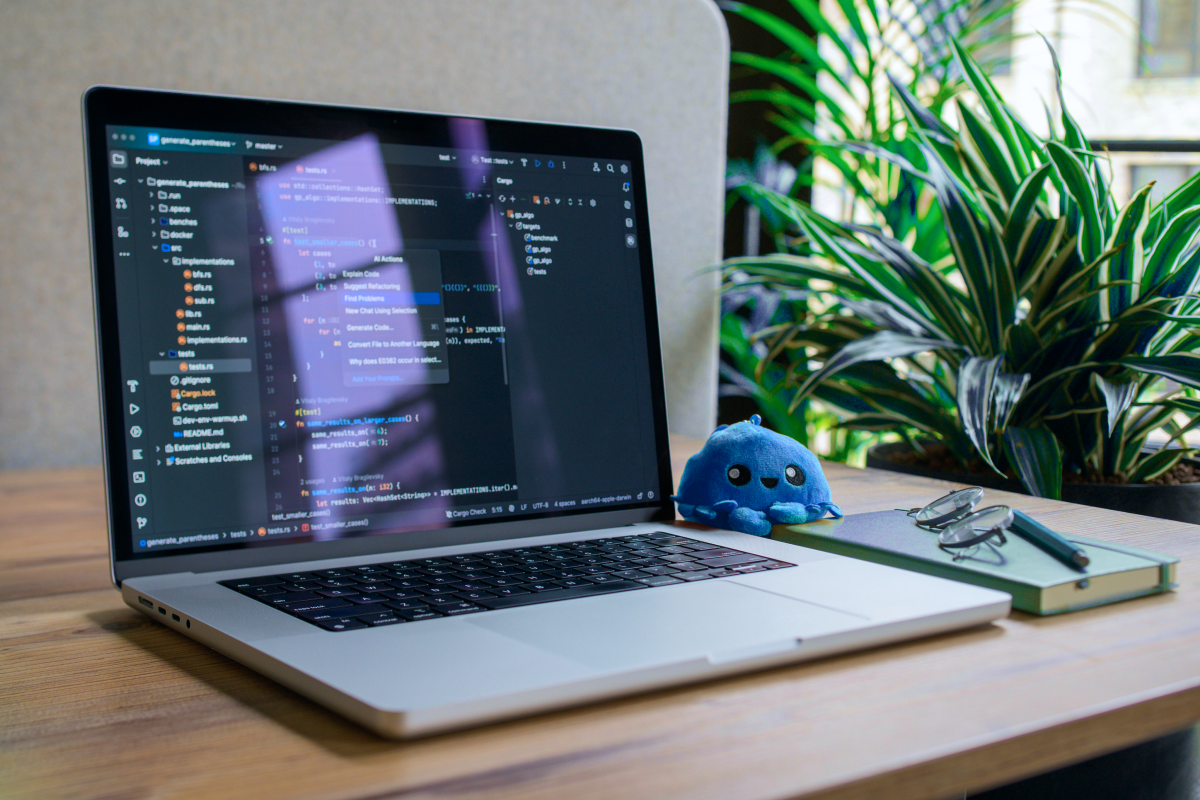SMBs marvel at what artificial intelligence (AI) can do, but most would hesitate to build AI-powered apps because of cost concerns. Among business owners, there’s a presumption that AI apps are extremely expensive to develop, especially those powered by advanced AI technologies. Moreover, the fact that training a deep learning model like GPT-3 costs over $4 million further fuels such worries.
Yet, how would you remain competitive if you shy away from developing AI apps or integrating AI with existing ones? Also, can SMBs afford the cost of AI app development? Rather than fall into presumptions, it’s better to clarify the confusion that you might have. Then, decide if innovating your business with AI is worth the investment.
This article is authored by Oleh Komenchuk – Machine Learning Engineer at Uptech, and Stan Burenko – Head of Business Development at Uptech. Together, we’ll shed light on how AI-powered apps are built and how much do they cost. We’ll also show you how you can reduce AI development costs while maintaining app quality.
Let’s start.

Artificial Intelligence Cost Estimation By The App Complexity
So, how much how much will it cost you to build an AI app? Probably not be as expensive as you imagined. But still, you’ll need to pay a substantial price to build the app. We’ve written an extensive article about it. You can explore the cost of implementing different types of AI here.
That said, most AI apps would cost between $30,000 to $150,000 based on our experience. The exact fee you pay depends on several factors, which we’ll explore later. Generally, you pay for a different range of basic, average, and complex AI apps.

Basic AI app
Apps with basic AI functionalities require little to almost no customization. They’re simple to build and integrate with a pre-trained foundational model. Because the model doesn’t require additional training, developers don’t commit excessive time and resources to it. Hence the fee is the least expensive.
Estimated fee: $30,000 - $60,000.
Average AI app
Most apps fall into this category. While they use pre-trained models, some degree of training or fine-tuning is required. Let’s say you want to build a chatbot for customer service workflow. You can use a foundational language model but still need to train it to understand the products your business offers. Because of the additional work, the fee is higher.
Estimated fee: $60,000 - $120,000.
Complex AI app
Be prepared to pay more if you’re developing an AI app that requires training from scratch. Model training involves dataset preparation, an exercise that potentially takes hundreds of hours. As such, these apps are the most expensive to build.
Estimated fee: Above $150,000.
If you want to learn more about the stages and the process of building a Generative AI solution from scratch, check our guide.
Top 10 Factors That Affect AI App Development Cost
Even with the cost estimate we showed above, you might find the development fee varies when requesting for a quote. That’s because many factors influence the cost of AI development.

Factor #1: App Development Process
Like other apps, you’ll need to go through specific stages to develop an AI product. And that’s where the bulk of the cost comes in. To give you a better idea, let’s briefly explore each stage we practice at Uptech.
Conduct market research
Before we develop your app, we’ll need to evaluate whether it’s feasible, has a market demand, and aligns with your business goals. On top of that, we explore compliance, security, and privacy requirements in the preliminary research. As we’re building an AI app, we must also pre-determine the AI model and assess whether model training is required.
Perform UI/UX and conversation design
Part of the process of building successful AI apps is to optimize customer engagement with UI/UX and conversation designs. For example, you can provide clear onboarding dialogue to assist users when they use an AI chatbot for the chatbot for the first time. Although you’re creating an AI app, it’s important to keep the messages human, which showcases warmth and personality.
Build a prototype
To reduce development risks, we build a prototype at minimal cost. A prototype is a visualized version of the app that gives users an idea of what it looks like. With a prototype, you can get early feedback from the target audience. Then, you can make changes and commit to developing the app further, knowing that you’re on the right track.
Develop the app
Here’s where most of the work happens. At this stage, developers gather data, create training samples, select an AI model, train, fine-tune, and perform other necessary tasks to build the solution. The time they take to build the app directly translates to the cost you pay.
You can learn more about how to build an AI software here.
Perform quality assurance
You can’t release the app until it’s adequately tested, especially one integrated with AI models. And this involves hours of testing, revising, and re-testing various app modules, integrations, and AI models.
How to outsource software testing? Check our guide to learn more.
Deploy the app
This stage is the cheapest, but there are marginal costs. To deploy the app, you’ll need to publish it on PlayStore or App Store. These marketplaces charge a fee to list your app. In addition, you should pay for hosting AI modules, they are usually hosted on cloud environments such as AWS.
Maintain and improvise
Once the app goes live, you can’t leave it without supervision. There might be bugs and vulnerabilities that escape QA tests or changes in trends requiring app revision. Though not as much as the development itself, you’ll still need to set apart a budget for app maintenance.
Factor #2: Complexity and the number of features
If your AI app is simple with only basic features, your cost will be low. On the other hand, you’ll pay a more significant fee if you want to build an AI app with complex integrations.
Let’s say you want to integrate your eCommerce app with a chatbot that responds to customer queries. The fee you need to pay is much lower than building an AI diagnosis tool for medical image analysis. In the latter, developers must pay more attention to compliance, training, fine-tuning, and model evaluation.
Also, the cost of developing an AI app can increase significantly if you require more features. For example, the fee is more expensive if your app requires:
- API integration
- IoT integration
- Phone sensors access
- Geolocation features
- Accessibility
Top that with training a deep learning model with a massive dataset, and you’ll likely pay more than $150,000.
Factor #3: Integration with Existing Systems
Another hurdle, which translates into cost, is AI integration with the systems that you currently use. To ensure the AI-powered app functions cohesively with existing systems, developers must modify the latter to ensure interoperability. Otherwise, the existing systems cannot exchange data with the AI app.
Often, the cost to integrate the new AI app with existing systems is manageable, but certain complications might inflate the cost. Imagine integrating an AI-powered retail sales system with a legacy inventory solution only to find out that the latter requires a total rebuild.
A complete system revamp is extremely costly. Therefore, it is only performed when developers have exhausted all other efforts. Often, developers attempt to build intermediary software to allow data exchange between systems, which is less expensive. At Uptech, we prefer to integrate systems with API. It lets us improve operational efficiency and scale our clients software quickly to meet growing demands.
Factor #4: AI Model Design and Development
Some SMBs are unaware that developing AI apps will cost more than a regular app. Apart from researching, prototyping, and developing the app, you must also develop the AI model. This requires specialized skill sets like machine learning, computer vision, and natural language processing (NLP).
AI developers possessing such skill sets command a higher rate than other app developers. But the good news is that app and AI model development can run almost parallelly. So, there’s no need to wait for the AI model to complete before working on the app, or vice versa.
Below, we share the stages our AI developer goes through when developing a model and how each stage impacts the overall cost.
Collect and prepare training data
Theoretically, you can use a pre-trained AI model without further training. But in practical applications, you’ll need to, at the very least, fine-tune the model so you can repurpose it for your business. To do that, you start by collecting data from various sources.
For example, if you want to build an AI assistant that recommends products based on customer interaction, you need to compile your product data and turn it into a model training sample.
Such effort is tedious and becomes more complicated if your business deals with sensitive data, such as medical records. Plus, most AI models need hundreds of thousands of data samples to perform optimally. Expect to spend more than $10,000 to collect, clean, and prepare the training data.
Choose the AI model
To date, SMBs have dozens of options when choosing AI models. If you want to create a chatbot, language models like GPT, Llama, and Bert are good options. But if you want to integrate your app with image recognition features, you’ll need Convolutional Neural Networks (CNN) and Vision Transformers (ViT).
Check our comprehensive guide about how computer vision works in healthcare.
Usually, the AI developer you partner with will help you decide which model suits your app requirements. Deciding a model doesn’t incur an expensive fee, but you’ll need to pay for licenses if you use proprietary models. As for Uptech, we use:
- GPT 3.5
- GPT 4
- GPT-4o
- GPT-4o mini
- DALL-E 3
- Mistral
- Claude
- Alpaca
- Stable Diffusion
Train and fine-tune the model
Depending on your approach, you might spend an expensive fee at this stage. To train a model, machine learning engineers provide it with massive training data. Over a process that might take weeks, the model gradually updates its weights and parameters from the training.
At Uptech, we recommend using pre-trained models, which are already trained by AI companies. The model only needs to undergo fine-tuning, which is less resource- and time-consuming.
Evaluate the model’s performance
Prior to integrating the AI model with the app, AI developers evaluate it for consistency, recall, accuracy, and other performance indicators. These terms might sound intimidating, but they’re important to ensure the AI model performs accurately and doesn’t generate biased responses.
Factor #5: Development Team and Location
Another factor that affects your cost is the AI developers you work with. Specifically, whether you’re hiring them in-house or partnering with outsourced developers.
In-house AI developers
If you hire an in-house team, be prepared to pay the salaries, perks, training, and other expenses your developers are entitled to. We know that not SMBs can sustain that for the long term because they need a large portion of their budget for app development.
Plus, if you’re based in developed countries like the US, your hiring costs will be high. For example, the annual salary for an AI developer based in the US is $129,348. Imagine paying such expenses to a team of highly skilled specialists for the long run—a painful commitment for many business owners.
Outsourced AI-developers
If you want to decrease AI software costs, outsourcing is the better approach. First, it frees you to the long-term commitment that comes with in-house hiring. Besides, you don’t need to divert your focus to training, managing, and leading the development team.
However, what most SMBs find outsourcing attractive is the access to talent worldwide and at a more affordable cost. For example, you pay $150 per hour to hire an independent AI developer in the US, but you can hire one in Ukraine for $50 per hour. Here’s a comparison of what AI app developers charge in various regions.

While business owners want to lower the cost when developing an AI app, it isn’t wise to choose a developer solely based on their rate. Rather, cultural fit, language barrier, and quality should be considered when partnering with an outsourced development team.
Here’s the list of the 12 best countries to outsource software development.
For example, global SMBs and startups like Dollar Shave Club outsource to Uptech. They save a substantial amount of development fee while receiving quality apps and support.

Factor #6: Development Platform
When you build an AI app, you also need to decide which platform the app is deployed on. And that decision can determine how much you eventually pay for the development.
Native apps
Native apps are apps designed specifically to run on Android or iOS. They are more complex and more costly to build. However, the advantage of these apps is that you can access the operating systems' native functionalities more effortlessly. For example, integrating cameras, microphones, and sensors is easier with native apps. You can learn more about the cost of building mobile apps here.
Web apps
Web apps run on browsers and behave almost similarly to native apps in terms of user interface and visuals. They are also cheaper to build and maintain because developers only need to create a single codebase. That said, web apps are not suitable if you need to access the phone’s hardware and other capabilities native apps provide.
Cross-platform apps
Cross-platform development lets you build an app that targets multiple platforms with a single codebase. Let’s say you want to launch your AI app on Android and Apple devices, but you don’t want to do the work twice. That’s where cross-platform apps come in.
In this approach, developers create codes using frameworks like Xamarin to build apps that are installable across different platforms. This approach saves time, effort, and money. The only caveat is — there’s a marginal gap in performance compared to native apps.
Choosing between native and cross-platform development? Check our article to make a wise decision.
Hybrid apps
Hybrid apps, as the name implies, run on the web and mobile on any platform. Like cross-platform apps, developers create and maintain only a single codebase. They’re also the most cost-friendly if you want to target users on all platforms. However, like web apps, you can’t access platform-specific features nor achieve the level of performance that native apps do.
Factor #7: Industry Specifics
Another variable you need to consider is the industry that your AI app serves. Some industries enforce stringent regulations, which your app must comply with. For example, an AI-powered medical app must comply with HIPAA, GDPR, and other local acts. In finance, apps must adhere to KYC regulations, PCI-DSS, and relevant data privacy acts.
To ensure compliance, developers must perform due diligence, such as going through the guidelines, creating a checklist, applying security measures, and auditing the app. These efforts will ultimately affect the final cost of building the AI app.
Want to learn more about fintech security, build a 100% secure app, and get the list of the key fintech regulations and policies? Get our fintech security checklist.
Factor #8: Hidden Costs
When you develop AI apps, be wary of hidden costs that may add up to a substantial sum. Like it or not, these costs are unavoidable, but knowing what they are can help SMBs plan and manage their budget accordingly.
AI infrastructure cost
Generative AI models like GPT consume a lot of computing power that regular servers can support. To train, deploy, and operate AI models, you need specialized hardware like GPUs and TPUs. The problem is these powerful processors are expensive. For example, NVIDIA’s Blackwell GPU costs up to $40k each, which few SMBs can afford. Plus, several GPUs are often required to train an AI model.
Alternatively, you can host the model on the cloud through providers like AWS. This way, you can scale the computing resources according to demand to minimize cost.
Data security cost
Training and operating generative models require collecting, storing, and exchanging massive volumes of data. That brings up another concern—security. Users are rightfully worried that AI apps risk being targeted by cybercriminals, which calls for mitigative measures to secure the data.
For example, we encrypt data that AI apps collect, store, and process. Our team also ensures that the code, database, and infrastructure are secured against data breaches and cybercriminal attempts. These measures, despite incurring additional costs, are necessary for your customer’s privacy.
App publishing fee
Though minimal, SMB owners must bear the cost of publishing their apps on the Apple App Store and Google PlayStore. Google charges a $25 one-time fee, while Apple charges $99 for yearly renewal.
Regulatory compliance costs
Some apps must comply with regulatory acts before they can be deployed in their respective marketplaces. To do that, you need to go through the relevant procedures, which might incur additional costs. For example, acquiring and retaining HIPAA compliance requires risk assessment, training, audit, and implementation of security measures, which might cost thousands of dollars annually.
Factor #9: AI App Maintenance and Optimization
We briefly mentioned the need to maintain your AI app after releasing it. Now, let’s dive deeper into the necessary tasks that you need to budget for.
Stakeholder training
Don’t assume that users, whether internal or external, can adapt or transition to the AI app seamlessly. In some cases, you’ll need to brief, train, and align their expectations with the AI features rolled out in the app.
AI performance monitoring
AI models, despite their intelligence, are not perfect. You’ll need a support team to continuously monitor the app for biased or inaccurate responses. This is particularly important if your app is applied in mission-critical applications, such as medical or finance.
System updates and bug fixes
Occasionally, your app requires minor updates to address bugs that manifest during actual usage. Also, as new versions of AI models become available, you might also need to revise the app to better address user’s needs.
As these tasks might be sporadic but require specialized skills, most SMBs outsource them to external app developers like Uptech. This way, they can focus on valuable business activities instead of tending to technical issues.
Factor #10: Team Composition
As much as you want to trim down the development team size, you need different specialized talents to develop an AI app. It’s unrealistic to hire a single AI developer and expect them to build the app to completion. Often, an AI development team consists of these roles:
- Project manager, who oversees and coordinates workflows amongst other team members.
- AI expert. A specialist advising and implementing tasks related to model selection, training, integration, and evaluation.
- UI/UX designers who create visually appealing interfaces and align the app to the customer journey.
- Business analysts, while not necessarily proficient in tech, are pivotal in ensuring the app achieves product market fit.
- App developers are mainly responsible for coding, building, testing, and supporting the app.
- Quality assurance engineers. They test the app to discover bugs, flaws, and vulnerabilities.
Together, the team contributes to your AI app’s success. But that also means you need to provision for the fee that each role commands. Below, we share a rough guideline of their respective rate if you hire them in the US.

Again, assembling a multi-skilled team can be costly if you’re hiring them from an expensive region. Rather, SMBs benefit financially by outsourcing their AI development needs to talents in Ukraine.
How to Reduce AI App Development Cost: 6 Ways
Unlike common misconceptions, AI development costs almost never extend beyond millions of dollars unless you’re training a billion-parameter model like GPT. That said, paying tens of thousands of dollars to build an AI product can stretch an SMB’s budget to its limit.
Understandably, business owners want to keep the cost of AI software as low as possible. Based on our experience, here’s what you can do.

1. Focus on core AI features first
AI can innovate various parts of the customer journey, but not all will deliver similar impacts to your business. So, don’t spend all your budget on AI features that customers don’t find useful. The worst thing about developing AI software is spending a hefty sum on meaningless features.
If you’re not sure which AI feature to focus on, we recommend conducting a thorough discovery phase to find out. Then, build an MVP to test it out. Then, improvise based on their feedback to create a purposeful and engaging product. By doing this, you can reduce the risks of a non-performing product and save unnecessary costs.
2. Choose a flexible tech stack
Don’t burden your development team with rigid software technologies. The time wasted in putting together incompatible coding tools, debuggers, and AI frameworks can result in additional costs and opportunity losses. Rather, use open-source platforms, low-code/no-node tools, plugins, and other software resources that can accelerate development.
3. Leverage pre-trained AI models
Just because OpenAI trains an entire GPT model from scratch doesn’t mean you need to follow suit. Such exercises cost millions of dollars and take months to complete. Many business owners couldn't afford the time and money that large AI enterprises could.
Besides, most apps that SMBs want to build don’t require complete model training. Fine-tuning, which exposes a pre-trained model to business-specific information, is more than enough. Instead of millions, you only pay thousands of dollars to prepare an AI model tailored to your specific needs.
4. Use cloud-based AI platforms
If you want to avoid investing in costly AI infrastructure, we suggest leveraging AI platforms offered by cloud providers. These cloud-based AI platforms let you train and operate generative AI models and pay only for the resources used. Plus, you don’t need to spend on provisioning, securing, and maintaining the servers in the long run.
5. Outsource to AI developers
Some SMBs want more control over their development workflow and prefer to hire in-house. But if you want to reduce AI implementation costs, consider outsourcing. Even if you outsource a portion of the development, you can greatly lower your recurring expenses.
Imagine saving more than half in salaries when you outsource to AI developers in Ukraine instead of hiring from local marketplaces. Or not having to pay for additional workspace, software licenses, training, and perks that in-house hire requires. Plus, you can access a broader pool of talents with specialization not easily accessible in your local marketplace.
6. Automate data labeling and preparation
Despite its sophistication, an AI model needs to learn from additional data to develop new knowledge of your business. These data need to be labeled so AI developers can use it to fine-tune the model. Data labeling, however, is a laborious process that increases expenses and development time.
Therefore, we recommend automating data preparation, including labeling. For example, you can use machine learning technologies to augment human annotators when labeling the data. This greatly speeds up the process and also reduces labeling mistakes.
AI App Development Cost: Uptech Cases
Every business is unique, and so is every AI app they build. As such, we can’t provide a deterministic figure until we truly understand a client’s requirement. That said, our team has developed several AI apps, and we’ll share some of the estimates.
Dyvo.ai for business
Dyvo.ai for business is an in-house AI app we built to help business owners capture professional-looking product photos. Think about capturing a snapshot of a dress on your phone and getting a studio-quality version of it in seconds with generative AI. On top of that, Dyvo.ai for business also features background removal, resizing, upscaling, and other tools to create brand-aligned product photos.
Cost: Apps similar to Dyvo.ai cost $25,000 to $50,000 to build.

Medical record summarizer
Another AI project we did was a medical record summarizer. Rather than building the entire app, we started with a proof of concept. Our goal is to reduce the time that healthcare professionals spend reviewing medical records. To do that, we retrieve key information from the records with AI and natural language processing technologies.
Cost: PoC starts from $10,000, a complete app potentially costing $30,000-40,000..
As you can see, the price of building AI software varies greatly. Every aspect influencing the development can dictate the final fee you pay. Though not in the range of millions, the expenses can still be overwhelming for small business owners.
In this guide, we’ve shared ways to reduce AI development costs and provided estimates based on the AI apps we built. If you need a more precise figure for your AI app's cost, reach out to our team now.
FAQ
How much will it cost to develop an AI app?
Be prepared to pay between $30,000 to $150,000 to build an AI app. For complex AI apps that require training the model from scratch, the fee could go beyond the average range. The cost that business owners bear depends on several factors, including feature complexities, data preparation, location of AI developers, and app platforms.
How much does an AI developer cost?
It depends on which country the AI developer is based in and the hiring model. AI developers in major economies like the US, UK, and Australia tend to command a more expensive fee, which often exceeds $150 per hour. However, you pay $50 per hour or less, if you outsource to talents in Ukraine, India, China, and other more affordable regions.
That said, don’t hire an AI developer based on cost alone. Consider quality, cultural fit, and communication barriers too because these factors will determine your project’s success.
Why should businesses invest in AI app development?
SMBs stand to lose their competitive advantage if they hesitate to innovate with generative AI. Still, an evolving technology, generative AI is already disrupting various industries and challenging how businesses conduct day-to-day operations. When you develop an AI app, you can:
- engage your customers by providing a personalized experience.
- automate repetitive tasks and free up time for more valuable business activities.
- save costs by operating with a leaner team and let AI do the heavy lifting.
- discover new opportunities made possible by generative AI’s capabilities.
- analyze business data at scale and use them to support decision-making.
































































































.avif)




